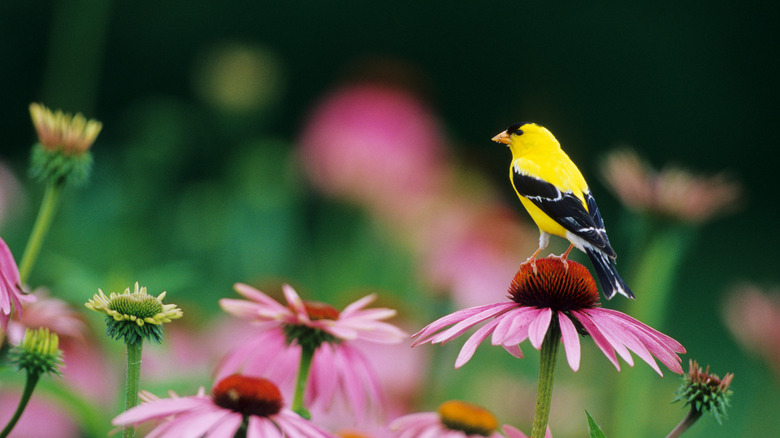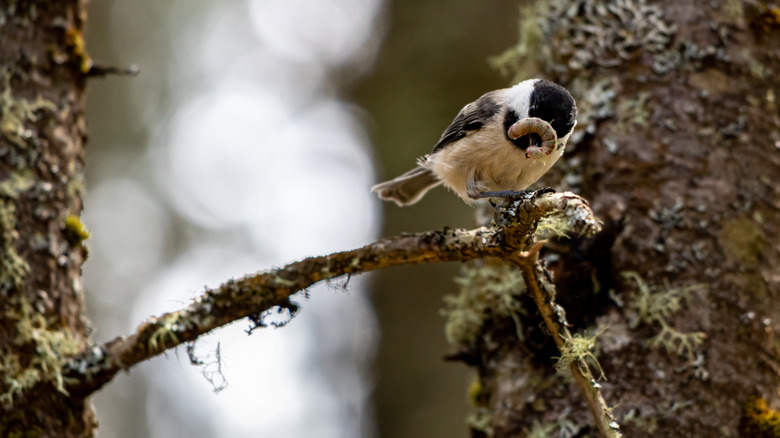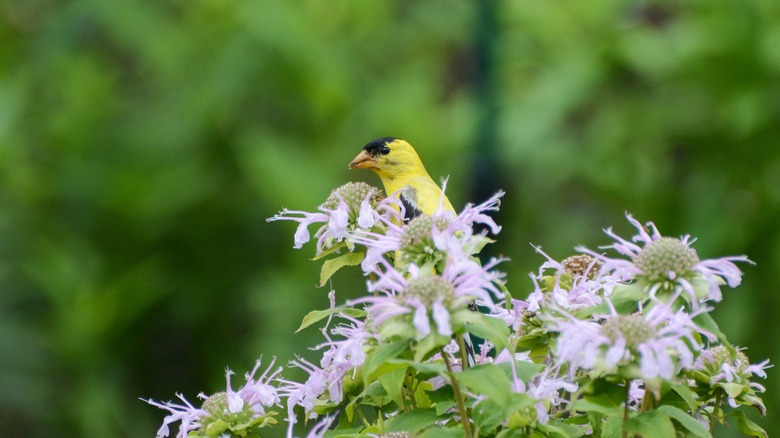Why Native Plants Are Perfect For Bringing Birds To Your Yard
There's nothing more delightful than a morning bird song in the spring. The sweet trilling and flutter of tiny wings are enough to cheer up even the saddest soul. It's no wonder we're hammering wooden birdhouses to our trees and Googling whether peanut butter is a safe food to add to our bird feeder. But there's an even simpler — and decidedly more earth-friendly — way to attract all kinds of twitterers to your backyard. It turns out birds go where the insects are. So, the easiest way to encourage insects is by planting native plants.
There's been a lot of talk in recent years about insect collapse — honey bees and monarch butterflies being a few of the "stars" in the tragedy. Declining insect populations have a ripple effect within the environment, first and foremost affecting birds. The chicks of around 96% of bird species in North America survive on insects alone, according to Doug Tallamy, author of "Bringing Nature Home," via the Virginia Department of Wildlife Resources. Insects and plants local to one another have evolved symbiotic relationships over thousands of years. Some insect lifecycles are intimately tied to a single plant family or species, like the aforementioned monarch and milkweed.
Transform your backyard
Botanists consider any plant species existing in North America before Europeans arrived native. Non-native plants are those from Europe or Asia introduced after this time. While many non-native plants resemble local varieties and species and may even be in the same family, they haven't adapted to suit the needs of local wildlife. If non-native varieties outnumber native plants, as they do in the urban, suburban, and farmed parts of the USA, they deprive local insects, mammals, and, most notably for this article, birds of food, shelter, and nest sites. Simply put, if you plant more native plants in your yard and reduce or eliminate exotics, you'll attract good insects into your yard. That, in turn, supports larger and more diverse bird populations.
Achieving a bird-friendly native yard doesn't mean ripping up your lawn or existing garden beds entirely, but you should be prepared to modify them. A 2018 study published in Proceedings of the National Academy of Sciences found that only land with at least 70% native plants supported breeding chickadees. First, spend time observing and auditing your existing garden. You might be surprised to find it already supports some native species. Take note, too, of climate and environmental specifics like how much rainfall you get and when, sunshine hours, seasonal temperature differences, and soil quality. Identify invasive non-native species and safely remove them.
How to source native plants
If you want to start small, go with flowering shrubs, which offer nesting sites, protection from predators, and nectar, pollen, and berries. To find out which native species are local to your area, consult one of the many online databases, like the Audubon Native Plants Database and the Lady Bird Johnson Wildflower Center native plant database. You can also consult with local garden centers or online nurseries specializing in native plants for expert advice. Non-profit group Garden for Wildlife ships their popular native plant starter packs right to your door for as little as $42. If you're on a budget, get cuttings, seedlings, or seeds from local garden group members or neighbors. Watch out for imposters — non-native plants with the same or similar names or visual features.
Native yards offer more benefits than attracting birds — which, by the way, help with weed and pest control, stress relief, and wildlife education opportunities for the littles in your life. They're also beautiful, low maintenance, and climate-friendly. They conserve water better and reduce soil erosion and the need for pesticides. What's more, many native plants self-seed, so eventually, your garden will grow itself! If you're unsure where to start or which plants are suitable for your site, get help from a local landscaper specializing in native garden design.


